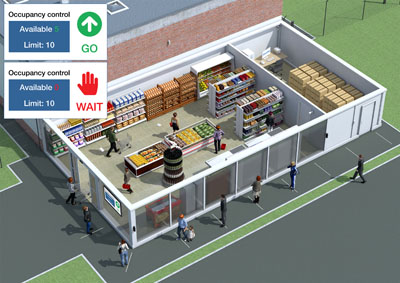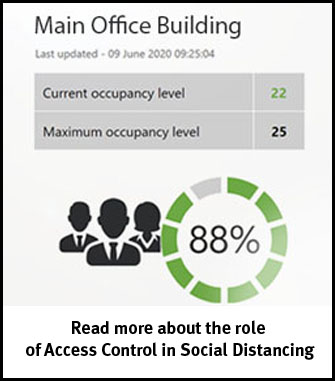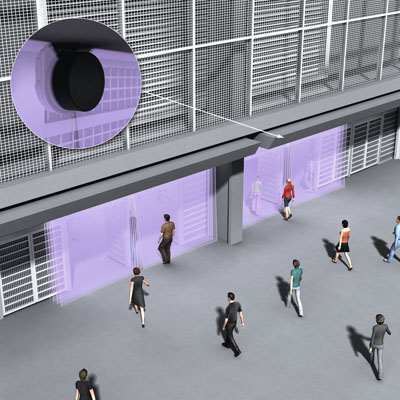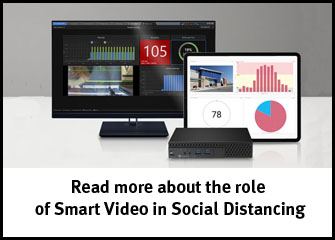As a growing number of businesses look to return to operations following the COVID-19 lockdown, so a number of regulations must be met to ensure COVID-secure workspaces and public areas. Permission for many types of businesses to open are contingent on the implementation of certain processes and procedures, and many of these have to do with social distancing and management of the movement of people.
The COVID-19 pandemic has impacted on a wide range of businesses and organisations, but as the lockdown measures are lifted, a growing number of businesses are able to recommence operations, albeit in a restricted and carefully managed way. Whilst the Government has published different guidance for various industry sectors, key to all the options is the need to enforce social distancing.
This is an area in which technology-based solutions can offer a wide range of benefits, ensuring businesses and organisations can comply with the various requirements. It also enables business owners to provide evidence they are complying with the requirements, and reassures customers, clients, visitors and contractors that the site in question is taking its obligations seriously.
The key to implementing good social distancing solutions lies in a combination of occupancy management, access control, behavioural analysis and the detection and reporting of exceptions. To date, in many key businesses and organisations, management of these tasks has been done manually. This approach was implemented because of the swift introduction of lockdown measures, and it allowed vital sites to switch to the new practices rapidly.
However, as industry and commerce moves to fuller operations, the use of manual systems is no longer the best approach. First, it places employees in a higher risk situation which some might find unacceptable. It also places pressure on employees if colleagues (and often superiors) are disinclined to follow guidance. It is also less cost-effective to deploy staff for marshalling duties, and it places a burden of monitoring and recording activities for compliance purposes on staff.
It is also important to consider that when implementing occupancy management and access control solutions, the benefits are not limited to management of social distancing during the COVID-19 pandemic. While the challenges associated with social distancing are forefront in the minds of many businesses and organisations at present, the technologies available also offer a wide range of business management benefits, ranging from security and safety to building management and business intelligence.
Implementing social distancing
The guidance offered to business owners and organisations seeking to return to operations includes a number of requirements for the management of occupancy. The core element of social distancing is based upon distancing: ensuring people remain a specified distance apart, dependent upon the space and other factors such as whether the location is internal or external, if masks or shields are in place, etc..
 This introduces a few variables: total occupancy of a space, the flow through the space of people, whether individuals need to be masked, queue management if there is a delay to entry or exit, plus some site specific needs based upon layout, security, health and safety, and so on.
This introduces a few variables: total occupancy of a space, the flow through the space of people, whether individuals need to be masked, queue management if there is a delay to entry or exit, plus some site specific needs based upon layout, security, health and safety, and so on.
It is important when considering distancing to understand the requirements are not limited to the amount of people in a given space, but also the density of people throughout the space. While an office might be large enough for ten people, for example, social distancing cannot be delivered in all ten are gathered in one corner of the space.
It is also important to consider how flow through the space will be managed. If, for example, a space can safely hold one hundred people, it is critical that once the capacity is reached, additional people cannot enter. As occupancy falls when people leave, additional occupants can be added on a one-out, one-in basis, or in batches if deep cleans need to take place.
Directional control is also critical. Where a site has multiple entrances, those used for entry and exit should be kept separate to reduce the changes of bottlenecks being created. Implementation of a one-way system in a site is recommended in COVID-secure guidance as it reduces instances of people crossing paths, but it can also be beneficial as it makes managing real-time occupancy a simpler task.
While the control of people through portals is important, as is detecting and identifying exceptions and violations to policies, taking appropriate action if social distancing rules are disregarded is equally important. Because of the critical nature of social distancing, notifications and actions need to be real-time. It is also important, however, that staff, customers, clients and visitors to a site are not made to feel embarrassed or victimised if they inadvertently make an innocent mistake which leads to a violation occurring.
The access control solution
All of the elements of social distancing might seem complicated to manage, but the technology exists to implement a number of necessary steps to make social distancing and occupancy management a simple and more efficient process. In many cases, businesses and organisations might already have the relevant solutions in place, but aren’t exploiting the full functionality on offer.
 Also, in recent months, many manufacturers and service providers have upgraded firmware or introduced new features to enhance occupancy management. Many of these additional features will be offered without charge or at a low cost. Additionally, where smart devices are used, these can be supplemented with cost-effective apps to enhance functionality.
Also, in recent months, many manufacturers and service providers have upgraded firmware or introduced new features to enhance occupancy management. Many of these additional features will be offered without charge or at a low cost. Additionally, where smart devices are used, these can be supplemented with cost-effective apps to enhance functionality.
One of the critical elements of social distancing is controlling the number of people in a space at any given time. The best way to achieve this will vary depending upon the needs of a site and the types of individuals who will be using the space.
For example, if the site is a business or organisation which is not public facing, the task is made somewhat simpler as employees, planned visitors and contractors can be issued with permanent or temporary credentials for an access control system. Many businesses and organisations will already have such a solution, and adapting some systems to be COVID-Secure is simple. Always check with the manufacturer or integrator to ensure relevant features and functions are available. Not all access control systems offer a high degree of flexibility. Older and lower cost solutions might be limited in terms of functionality.
Temporary credentials can be sent to visitors and contractors across the air, allowing them to use mobile devices as the access token. This prevents the need to issue and collect (and disinfect) cards or tokens. Staff can use their everyday credentials for access and egress.
If the site has potential bottlenecks such as entrance lobbies, corridors to offices or departments, etc., staff can have their access privileges adjusted to initiate and enforce staggered start times. For example, departments could start work 15 or 20 minutes apart, ensuring personnel have passed through any common areas before the next wave arrives. This is achieved by setting access times by department. Users will not be granted access outside of their allocated time window.
To ensure staggered starts are COVID-Secure, staff should be asked to wait in their vehicles or in socially distance queues if arriving before their allocated time slot.
Another benefit of access control is that doors can be set as entry only or exit only. This requires the use of two-way reading, or the relocating of readers. As such, the system will not allow a door to be opened from the incorrect side. If an attempt is made (in the case of two-way reading), a notification could be shown on a screen, and a log of those staff who need to be reminded of correct procedures can be saved if necessary.
Entry and exit readers can also be linked with automatic door openers to reduce the need to touch handles.
 While staggered starts allow common areas to be kept clear, there may also be the need to control occupancy of a specific area. Most credible access control systems with two-way reading (an access control credential is required to enter and leave the space) should be able to define an occupancy limit. If, for example, a space can safely hold 40 people, the 41st user will be denied access. Dependent upon site requirements, a one-out, one-in policy can be introduced, with access only permitted when someone leaves. Alternatively, if deep cleaning is required between activity, the system can be set to only allow entry after the occupancy has fallen to a specified level.
While staggered starts allow common areas to be kept clear, there may also be the need to control occupancy of a specific area. Most credible access control systems with two-way reading (an access control credential is required to enter and leave the space) should be able to define an occupancy limit. If, for example, a space can safely hold 40 people, the 41st user will be denied access. Dependent upon site requirements, a one-out, one-in policy can be introduced, with access only permitted when someone leaves. Alternatively, if deep cleaning is required between activity, the system can be set to only allow entry after the occupancy has fallen to a specified level.
When looking to adapt access control to meet occupancy management needs, it is critical to remember that clear and concise information should be available. If a worker cannot access the canteen, for example, because occupancy levels are too high, they need to know the reason. Without an understanding of why they’re being denied access, they’re more likely to attempt to find another way to enter the space.
The video solution
Access control offers accurate counting and enforced control in situations where all users have an issued credential. They also allow automated control of doors, thus managing the flow of people. However, for many sites it won’t be efficient to issue credentials to every visitor. In such applications, video analytics can offer a solution.
 When deploying video analytics, it is important to remember that systems are not 100 per cent accurate, so adjustments need to be factored in to ensure restrictions are met. Often the discrepancies are little more than a few per cent, so the technology still delivers a viable solution.
When deploying video analytics, it is important to remember that systems are not 100 per cent accurate, so adjustments need to be factored in to ensure restrictions are met. Often the discrepancies are little more than a few per cent, so the technology still delivers a viable solution.
The most common video analytics for occupancy management will be people counting and occupancy detection. However, there are other algorithms which can enhance the performance of a solution, such as wrong way detection, loitering and heat mapping. One benefit is that multiple analytics rules can be used simultaneously thanks to recent increases in available processing power, both at the edge (camera) and at the server.
People counting can be carried out by using cameras at entrance and exit points. These solutions make use of a virtual line (or two lines to verify accuracy) and increment each time a person enters a space and reduces the count total as required when they leave. Directional discriminations can be set for each line, thus allowing them to be used where separate entrances and exits exist, or where one doorway is used for both.
It is worth considering whether legacy surveillance cameras can be used for people counting. Some devices need to be ceiling mounted, looking down over the monitored area. However, with the expansion of object classification in AI-enabled systems, there are options which can use conventionally mounted devices.
While the camera performing the count simply reports occupancy levels, the VMS the camera is connected to will use the data to create rules. For example, when an area reaches a defined percentage of occupancy (for example, 80 per cent), a notification can be sent to management. If the figure reaches 90 per cent, signage could be used to ask customers to wait, doors or turnstiles could be closed, announcements broadcast or staff deployed to control and restrict access.
 Analytics to detect overcrowding could also be implemented. While the occupancy of an area might be within safe guidelines, the safety of customers and staff could be compromised if they’re gathered in one area, such as near a popular display in a retail environment. Overcrowding detection, density measurements and heat-mapping can identify areas where social distancing isn’t being achieved, allowing other measures to be taken to increase distancing.
Analytics to detect overcrowding could also be implemented. While the occupancy of an area might be within safe guidelines, the safety of customers and staff could be compromised if they’re gathered in one area, such as near a popular display in a retail environment. Overcrowding detection, density measurements and heat-mapping can identify areas where social distancing isn’t being achieved, allowing other measures to be taken to increase distancing.
Loitering detection can be used to quickly identify if people are waiting in areas which might be potential bottlenecks such as stairwells, corridors or other common areas. Such events can be addressed through digital signage, announcements, notifications to staff or the automation of doors or turnstiles.
While video analytics and VMS rules can significantly add to the management benefits when implementing occupancy management, another benefit of such solutions is the ability to deliver real-time reports to users. Accessible from the video system or via smartphones, tablets, PCs or network-connected displays, users can access easy-to-understand graphical reports which clearly indicate the status of various spaces across the site.
LiDAR options
LiDAR offers light detection and ranging, allowing the sensing of objects in 3D. Although more widely used in industrial detection applications, these sensors are increasingly used for other purposes as they become more cost-effective.
While standard sensors detect motion or objects in the field of view. LiDAR devices can pinpoint objects using X and Y coordinates, allowing them to generate data relating to the number of objects in the field of view and their position to each other.
The data from LiDAR detectors can be used by some leading VMS software, allowing the accurate real-time data to be used in Rules to identify breaches of occupancy control.
In summary
The coming months represent a challenge for many businesses, and experts have suggested that some elements of social distancing will be necessary for more than a year. Fears over a winter spike also underline the need for credible policies to be in place to ensure businesses and organisations are prepared for further waves of the pandemic.
Technology can play a significant part in occupancy management, whether that be through the use of access control, video analytics or smart detection.
It is important to remember these technologies are not new. They are well established and deliver a wide range of business benefits. As such, an investment in solutions should not be viewed as being COVID-19 specific. Even in a pandemic-free world, the systems will add value and deliver a return on investment.
READ ABOUT NET2 WITH OCCUPANCY MANAGEMENT FROM PAXTON
READ ABOUT GENETEC’S OCCUPANCY MANAGEMENT PACKAGE








